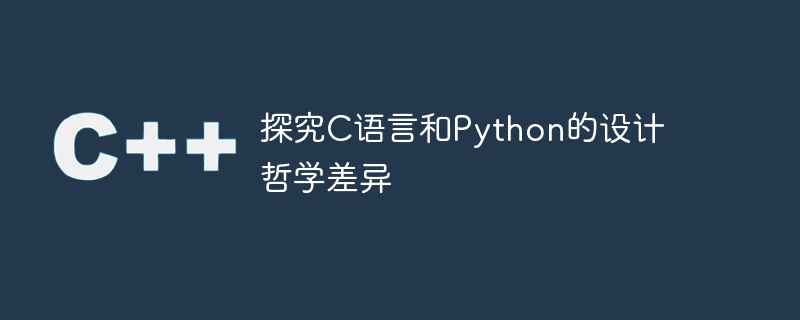

As two different types of programming languages, C language and Python have their own unique design philosophies and characteristics. This article will explore the differences between C language and Python from the perspective of design philosophy, and demonstrate the differences through specific code examples.
C language is called a "static" and "low-level" programming language, and its design focuses on performance and efficiency from the beginning. Its design philosophy mainly includes the following aspects:
1.1 Simplicity and efficiency:
C language focuses on concise and clear syntax and efficient execution speed, emphasizing that "as a programmer, you should Know what you are doing”. It provides a rich set of low-level functions that allow programmers to exercise fine control over the computer's hardware details.
1.2 Manual memory management:
Memory management in C language requires programmers to perform manual operations, including memory allocation and release. This degree of freedom gives programmers more control, but can also easily lead to problems such as memory leaks or dangling pointers.
1.3 Strong typing:
C language is a strongly typed language that requires strict definition of variable types and type conversion. This increases the stability and reliability of the program, but also makes some operations during the programming process slightly cumbersome.
Python is a "dynamic" and "high-level" programming language that focuses on the readability and simplicity of the code. Its design philosophy is mainly reflected in the following aspects:
2.1 Simplicity and elegance:
Python is famous for its simplicity and elegance, emphasizing the readability and maintainability of the code. Its syntax is concise and clear, reducing the memory burden on programmers. It also provides a rich standard library and third-party libraries to facilitate rapid development.
2.2 Automatic memory management:
Python has a powerful memory management mechanism and supports automatic garbage collection. This design reduces the burden on programmers and avoids some common memory errors.
2.3 Dynamic typing:
Python is a dynamically typed language. There is no need to specify the type of variables, and type conversion can be automatically performed as needed. This simplifies the coding process and increases flexibility, but may also introduce some potential type errors.
The following uses specific code examples to demonstrate the differences in design philosophy between C language and Python:
#include <stdio.h>
int main() {
int i;
for (i = 0; i < 5; i ) {
printf("Hello, World!
");
}
return 0;
}In C language, the variable type needs to be explicitly declared and the scope of the loop defined, and the programmer needs to personally manage memory allocation and release.
for i in range(5):
print("Hello, World!")In contrast, in Python, the code is more concise, there is no need to explicitly declare types, and there is no need to manually manage memory.
Through the above exploration of the design philosophies of C language and Python and the comparison of code examples, we can see the differences between the two languages. C language emphasizes performance and efficiency and requires programmers to manually manage memory, while Python focuses on the simplicity and readability of code and has a powerful memory management mechanism. Choosing which language to use depends on specific needs and project requirements. Reasonable selection of suitable programming languages can improve development efficiency and code quality.
The above is the detailed content of Explore the differences in design philosophies between C language and Python. For more information, please follow other related articles on the PHP Chinese website!




